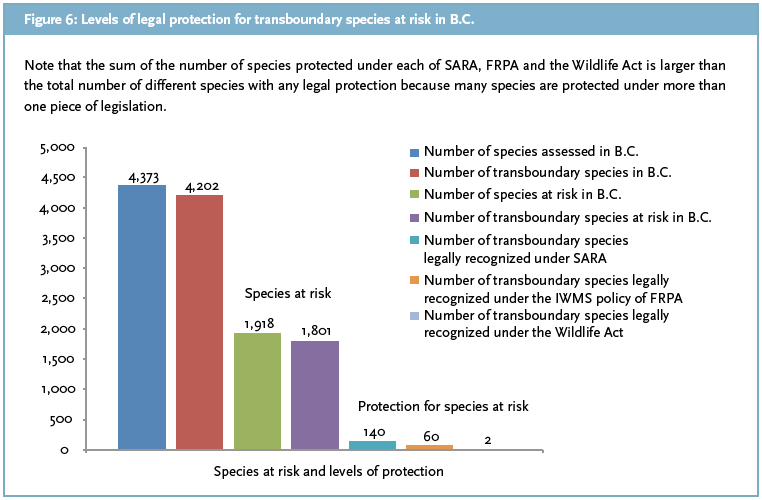|
| |
| 9. Dezember 2010 |
Völlig ungenügender Schutz von Tier- und Pflanzenarten
in BC – 42 Prozent sind von der Ausrottung bedroht |
| |
| Eine Studie, die gemeinsam von der David Suzuki Foundation, von Ecojustice und Conservation Northwest herausgegeben wurde, liefert erschreckende Erkenntnisse über den Artenschutz in BC (Connolly, M., Ferguson, K., Pinkus, S. & Moola, F. (2010). On the Edge. British Columbia’s Unprotected Transboundary Species). Diese Studie steht auch online zur Verfügung unter: www.davidsuzuki.org -> issues -> wildlife & habitat. |
| BC ist die artenreichste Provinz Kanadas mit 4373 vorkommenden Tier- und Pflanzenarten. 4202 hiervon (96 %) sind grenzüberschreitend vorkommende Arten, sogenannte „transboundary species“, d. h. sie kommen sowohl in BC als auch in den Nachbarprovinzen Kanadas und in den angrenzenden US-Bundesstaaten vor (Washington, Idaho, Montana, Alaska, Alberta, Yukon, Northwest Territories). Leider sind bereits 1801 Arten dieser transboundary species in BC vom Aussterben bedroht (42 %) und trotzdem sind nur 9 % dieser Arten gesetzlich geschützt durch das kanadische Species at Risk Act (SARA), durch das BC Forest and Range Practices Act (FRPA) oder das BC Wildlife Act. 1635 Arten sind ungeschützt, obwohl sie als vom Aussterben bedroht gelten. Eine Übersicht über den ungenügenden Schutzstatus gibt die Abbildung 6 der Studie. |
| |
 |
Schutzstatus von grenzüberschreitend vorkommenden Arten in BC
© Connolly, M., Ferguson, K., Pinkus, S. & Moola, F. (2010). On the Edge. British Columbia’s Unprotected Transboundary Species. |
| |
| Die Studie kommt zu folgendem Schluss: „Despite the importance of transboundary ecosystems and species, their increasingly imperilled status, and B.C.’s commitments to protect biodiversity in the province, current protections in B.C. are woefully inadequate. Habitat loss and degradation is the greatest short-term threat to B.C.’s biodiversity, affecting 86 per cent of B.C.’s species at risk. The effects of global warming are predicted to increase the vulnerability of species to extinction. Yet neither of these threats has yet been directly – let alone adequately – addressed for more than a tiny proportion of B.C.’s transboundary species.“ |
| Erschreckend ist auch der Vergleich des Artenschutzes in BC mit dem in anderen Staaten und Provinzen. Von allen kanadischen Provinzen haben nur Alberta und BC kein Artenschutzgesetz: „B.C.’s lack of adequate legal protections for species at risk is further highlighted by comparison to neighbouring jurisdictions. In particular, in the U.S. the federal Endangered Species Act (ESA) applies to all lands in that country, including state and private lands, and all endangered wildlife species are automatically protected from ‚take‘, which includes killing, harming or significant habitat modification or degradation (and individual states can then add stronger protections on top of the ESA). Thus legal protections for species at risk in neighbouring U.S. jurisdictions are significantly stronger than in B.C.“ Wildtiere machen bei ihren Wanderungen nicht an Staatsgrenzen halt und geraten so immer wieder in Gefahren, wenn sie die Grenzen nach BC überschreiten, wo sie nicht mehr geschützt sind und abgeschossen werden dürfen. „If a grizzly bear in Montana wanders a few kilometers north in search of mate, it goes from being protected by the US Endangered Species Act to being a possible target of a trophy hunter in BC“, erklärte Michelle Connolly von der David Suzuki Foundation. „This clearly demonstrates the urgent need for BC to pass its own endangered species law – animals shouldn’t need passports to get protection.“ Auch andere Tierarten sind von der Rückständigkeit der Regierung in BC in Bezug auf den Artenschutz betroffen. „Species like lynx are seriously endangered in the shared habitats of the US and BC, but are only protected south of the border. Unfortunately protections for such vulnerable wildlife are more like legal dead ends than two-way streets“, sagte Joe Scott von Conservation Nortwest. Michelle Connolly nennt weitere Beispiele: „Wolverines, coastal giant salamanders and spotted owls that cross the border from Washington into B.C., unknowingly step into a hostile political landscape that does nothing to prevent their habitat from being destroyed by a highway, ski resort or a mine, even though these critters are considered to be at-risk of endangerment in B.C.“ |
| Die Autoren der Studie machen der Provinzregierung von BC fünf Vorschläge, um zu einem verbesserten Artenschutz zu kommen. Der wichtigste hiervon lautet: „B.C. should enact a Species and Ecosystem Protection Act (SEPA) that identifies species and ecosystems at risk and then provides for their protection and recovery, including habitat protection.“ Die Studie gibt der Provinzregierung von BC unter einem neu zu wählenden Premierminister einen dringenden Appell mit auf den Weg: „B.C. has the most plant and animal species of any province in Canada, and most of this biodiversity is made up of transboundary species, almost half of which are already at risk of disappearing from B.C. Without transboundary species and peripheral populations, significant parts of B.C.’s biodiversity would be lost, jeopardizing the healthy functioning of many ecosystems and the provision of critical ecosystem services that sustain the well being of British Columbians. If we want to maintain this biodiversity, B.C. should take new action that includes: enacting new legislation to protect ecosystems and the species they contain and adding additional protected areas to ensure habitat connectivity and the capacity to adapt to global warming.“ |
| |
 zurück zurück |
|
|

